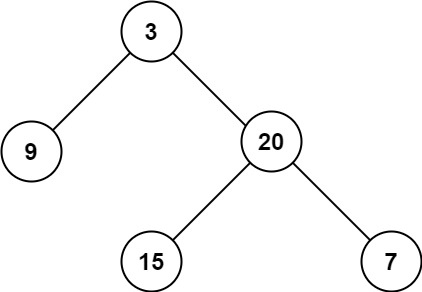Problem
Given the root of a binary tree, return its maximum depth.
A binary tree’s maximum depth is the number of nodes along the longest path from the root node down to the farthest leaf node.
Example 1:

Input: root = [3,9,20,null,null,15,7] Output: 3
Example 2: Input: root = [1,null,2] Output: 2
Constraints:
- The number of nodes in the tree is in the range
[0, 104]. -100 <= Node.val <= 100
Solution
/**
* Definition for a binary tree node.
* struct TreeNode {
* int val;
* TreeNode *left;
* TreeNode *right;
* TreeNode() : val(0), left(nullptr), right(nullptr) {}
* TreeNode(int x) : val(x), left(nullptr), right(nullptr) {}
* TreeNode(int x, TreeNode *left, TreeNode *right) : val(x), left(left), right(right) {}
* };
*/Modified Level Order Traversal - O(n) time - O(n) space
using namespace std;
class Solution {
public:
int levels;
void helper(TreeNode* node, int level) {
if (levels == level) levels++;
if (node->left != nullptr) helper(node->left, level +1);
if (node->right != nullptr) helper(node->right, level +1);
}
int maxDepth(TreeNode* root) {
if (root == nullptr) return 0;
helper(root, 0);
return levels;
}
};Improved Level Order Traversal - O(n) time - O(n) space
class Solution {
public:
int maxDepth(TreeNode *root) {
if (root == nullptr) return 0;
return max(1 + maxDepth(root -> left), 1 + maxDepth(root -> right));
}
};Tail Recursion
class Solution {
private:
// The queue that contains the next nodes to visit,
// along with the level/depth that each node is located.
queue<pair<TreeNode*, int>> next_items;
int max_depth = 0;
/**
* A tail recursion function to calculate the max depth
* of the binary tree.
*/
int next_maxDepth() {
if (next_items.size() == 0) {
return max_depth;
}
auto next_item = next_items.front();
next_items.pop();
auto next_node = next_item.first;
auto next_level = next_item.second + 1;
max_depth = max(max_depth, next_level);
// Add the nodes to visit in the following recursive calls.
if (next_node->left != NULL) {
next_items.push(make_pair(next_node->left, next_level));
}
if (next_node->right != NULL) {
next_items.push(make_pair(next_node->right, next_level));
}
// The last action should be the ONLY recursive call
// in the tail-recursion function.
return next_maxDepth();
}
public:
int maxDepth(TreeNode* root) {
if (root == NULL) return 0;
// Clear the previous queue.
std::queue<pair<TreeNode*, int>> empty;
std::swap(next_items, empty);
max_depth = 0;
// Push the root node into the queue to kick off the next visit.
next_items.push(make_pair(root, 0));
return next_maxDepth();
}
};Stack
We start from a stack that contains the root node and the corresponding depth which is 1. Then we proceed to the iterations: pop the current node out of the stack and push the child nodes. The depth is updated at each step.
class Solution {
public:
int maxDepth(TreeNode* root) {
if (root == NULL) return 0;
vector<pair<int, TreeNode*>> my_stack;
my_stack.push_back(pair<int, TreeNode*>(1, root));
int max_depth = 0;
while (!my_stack.empty()) {
pair<int, TreeNode*> my_pair = my_stack.back();
int c_depth = get<0>(my_pair);
TreeNode* c_node = get<1>(my_pair);
max_depth = max(max_depth, c_depth);
my_stack.pop_back();
if (c_node->left != NULL) {
my_stack.push_back(pair<int, TreeNode*>(c_depth + 1, c_node->left));
}
if (c_node->right != NULL) {
my_stack.push_back(pair<int, TreeNode*>(c_depth + 1, c_node->right));
}
}
return max_depth;
}
};